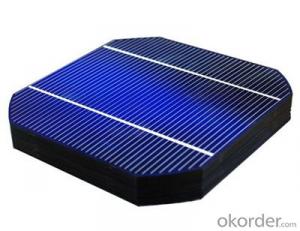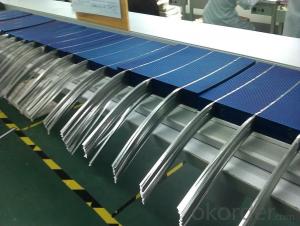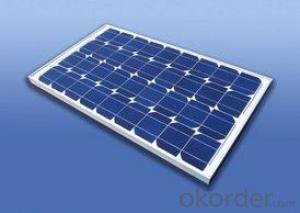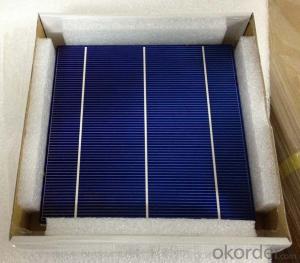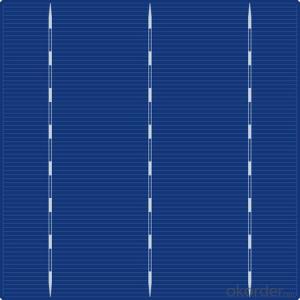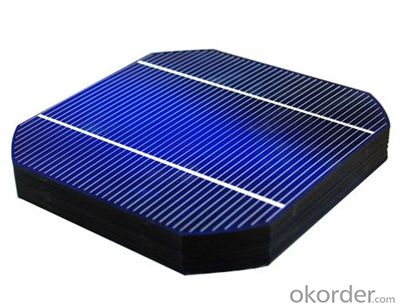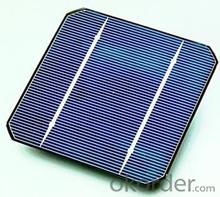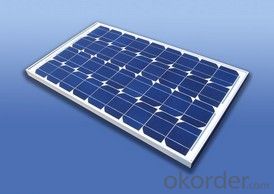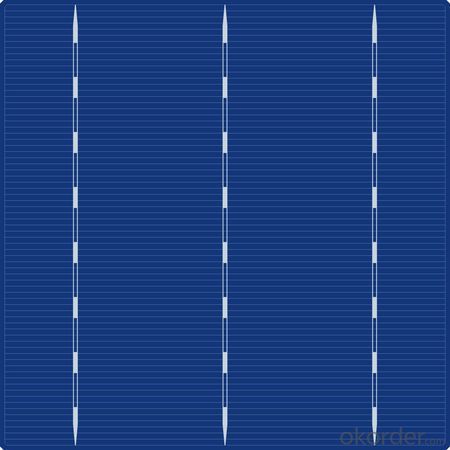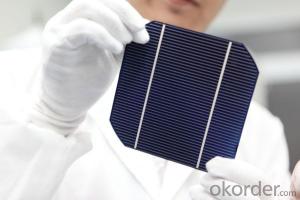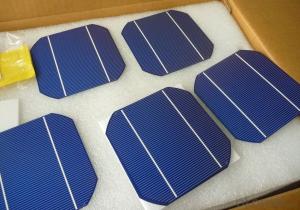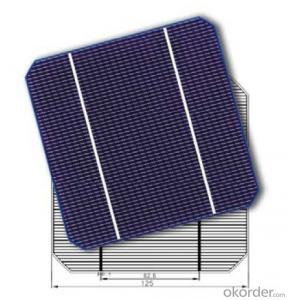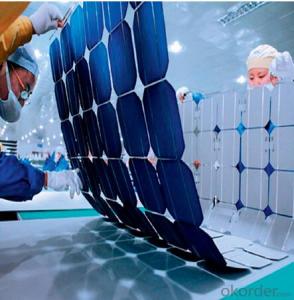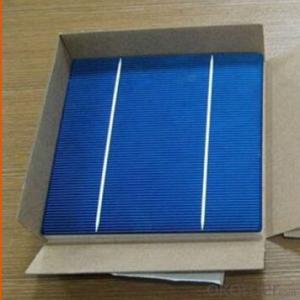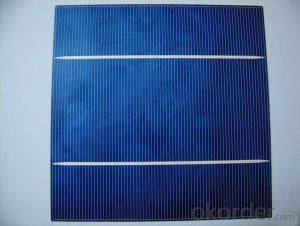Utj Solar Cells - Monocrystalline Silicon Solar Cells 125mm (16.50%-18.35%)
- Loading Port:
- Shanghai
- Payment Terms:
- TT OR LC
- Min Order Qty:
- 1000 watt
- Supply Capability:
- 100000000 watt/month
OKorder Service Pledge
OKorder Financial Service
You Might Also Like
Specification
1.Description of the Solar Cells
Monocrytalline Silicon Solar Cells 125mm (16.50%----18.35%)
We supply regular mono 125x125mm and poly 156x156mm solar cells.
Cells made in China mainland and Taiwan are both available.
Cell production capacity yearly reach 1GW.
Our cells pattern include continuous and uncontinuous busbar to meet different cells line.
2.Mechanical data and design of the Solar Cells
| Format | 125 mm × 125 mm ± 0.5 mm |
| Thickness- | 210 μm ± 40 μm |
| Front (-) | 1.6 mm bus bars (silver),blue anti-reflection coating (silicon nitride) |
| Back (+) | 2.5 mm wide soldering pads (silver) back surface field (aluminium) |
3. Temperature Coefficient of the Solar Cells
| Voc. Temp .coef.%/K | -0.35%/K |
| Isc . Temp .coef.%/K | +0.024%/K |
| Pm. Temp. coef.%/K | -0.47%/K |
4.Electrical Characteristic of the Solar Cells
Efficiency (%) | Pmpp (W) | Umpp (V) | Impp (A) | Uoc (V) | Isc (A) | FF (%) | ||
18.35 | 2.841 | 0.532 | 5.342 | 0.631 | 5.67 | 79.41% | ||
18.2 | 2.817 | 0.53 | 5.319 | 0.631 | 5.64 | 79.16% | ||
18.05 | 2.794 | 0.527 | 5.301 | 0.63 | 5.63 | 78.77% | ||
17.9 | 2.771 | 0.527 | 5.259 | 0.629 | 5.62 | 78.39% | ||
17.75 | 2.748 | 0.526 | 5.224 | 0.629 | 5.61 | 77.88% | ||
17.6 | 2.725 | 0.524 | 5.201 | 0.629 | 5.59 | 77.50% | ||
17.45 | 2.702 | 0.52 | 5.196 | 0.629 | 5.586 | 76.90% | ||
17.3 | 2.678 | 0.516 | 5.183 | 0.626 | 5.577 | 76.71% | ||
17.15 | 2.655 | 0.513 | 5.175 | 0.623 | 5.565 | 76.58% | ||
17 | 2.632 | 0.51 | 5.161 | 0.622 | 5.559 | 76.12% | ||
16.75 | 2.593 | 0.508 | 5.103 | 0.615 | 5.477 | 76.98% | ||
16.5 | 2.555 | 0.506 | 5.047 | 0.608 | 5.396 | 77.88% | ||
5.Intensity Dependence of the Solar Cells
Intensity [W/m2] | sc× [mA] | Voc× [mV] |
1000 | 1.00 | 1.000 |
900 | 0.90 | 0.989 |
500 | 0.50 | 0.963 |
300 | 0.30 | 0.939 |
200 | 0.20 | 0.920 |
6.IV Curve of the Solar Cells
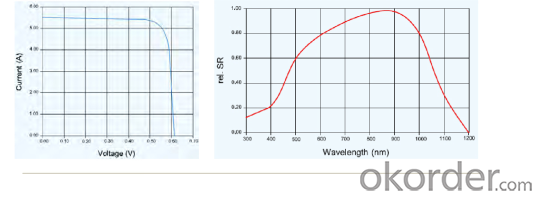
7.Applications of the Solar Cells
electric power generation
8.IMages of the Solar Cells

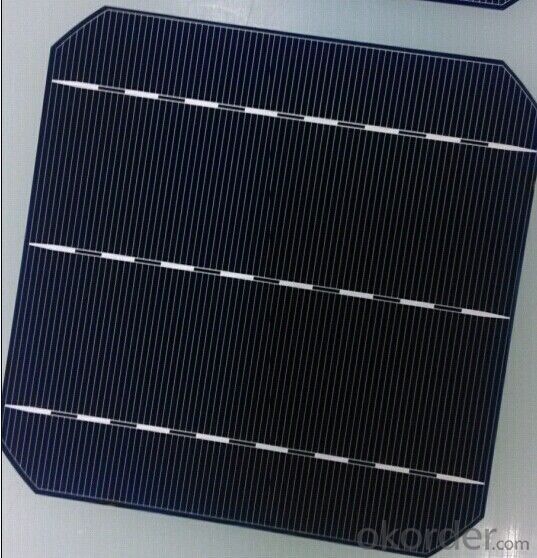

FAQ
- Q: How do solar cells handle partial shading?
- Solar cells handle partial shading by using bypass diodes. These diodes allow the current to bypass the shaded area, ensuring that the rest of the solar cell continues to function efficiently. By redirecting the current, the solar cells can still generate power even if some parts are shaded, minimizing the impact of partial shading on overall performance.
- Q: Can solar cells be used for cooking?
- Yes, solar cells can be used for cooking by converting sunlight into electrical energy, which can be used to power electric stoves or heat sources for cooking.
- Q: Can solar cells be used in art installations?
- Yes, solar cells can be used in art installations. They can be integrated into various artistic designs and sculptures to generate renewable energy and add an innovative and sustainable element to the artwork.
- Q: Can solar cells be used in space satellites?
- Yes, solar cells can be used in space satellites. In fact, solar cells are commonly used in satellites to generate electricity from the sunlight in space. These cells convert sunlight into electrical energy, which is then used to power various systems and instruments onboard the satellite.
- Q: Can solar cells be used to power remote locations?
- Yes, solar cells can be used to power remote locations. Solar cells convert sunlight into electricity, making them an ideal renewable energy source for areas that are not connected to the traditional power grid. They can be installed in remote locations to generate electricity and provide a reliable power supply. Additionally, solar cells are low-maintenance and have a long lifespan, making them a cost-effective solution for powering remote areas.
- Q: Can solar cells be used in security systems?
- Yes, solar cells can be used in security systems. Solar-powered security systems utilize solar cells to convert sunlight into electricity, which is then stored in batteries to power the system. This allows for independent operation and eliminates the need for a constant power supply or wiring, making solar-powered security systems an efficient and sustainable choice.
- Q: Is it complicated to make a solar cell work well?
- My chemistry teacher told me that as long as you have enough knowledge, you can make a solar cell work very well.
- Q: Can solar cells be used for telecommunications infrastructure?
- Yes, solar cells can be used for telecommunications infrastructure. Solar cells convert sunlight into electricity, providing a renewable and sustainable source of power. By utilizing solar cells, telecommunication infrastructure such as cell towers, base stations, and remote communication devices can be powered independently, even in remote areas without access to the electrical grid. This helps to reduce reliance on fossil fuels, lower operational costs, and increase the reliability of telecommunications networks.
- Q: How are solar cells made?
- Solar cells are typically made using a process called photovoltaic manufacturing, which involves several steps. First, silicon, which is the main material used in solar cells, is extracted from silica, a component of sand. The extracted silicon is then purified and transformed into a crystal structure suitable for solar cell production. These silicon wafers are then cut into thin slices. Next, various layers of conductive materials and anti-reflective coatings are applied to the wafer, creating the necessary electrical properties and enhancing light absorption. Finally, electrical contacts are added to the cell, allowing the generated electricity to be collected and used.
- Q: What are the main components of a solar cell?
- The main components of a solar cell are the semiconductor material, typically made of silicon, which absorbs sunlight and converts it into electricity, and the metal contacts on the top and bottom layers of the cell, which allow the generated electricity to be collected and transferred to an external circuit.
Send your message to us
Utj Solar Cells - Monocrystalline Silicon Solar Cells 125mm (16.50%-18.35%)
- Loading Port:
- Shanghai
- Payment Terms:
- TT OR LC
- Min Order Qty:
- 1000 watt
- Supply Capability:
- 100000000 watt/month
OKorder Service Pledge
OKorder Financial Service
Similar products
Hot products
Hot Searches
Related keywords
